Organizational Change: Sustainable Competitive Advantage
VerifiedAdded on 2023/04/20
|8
|1759
|204
AI Summary
This essay explores the concept of organizational change and its relationship with sustainable competitive advantage. It discusses the challenges and barriers to successful change implementation and provides strategies for overcoming them. The importance of employee involvement, communication, and training in facilitating smooth transitions is emphasized.
Contribute Materials
Your contribution can guide someone’s learning journey. Share your
documents today.
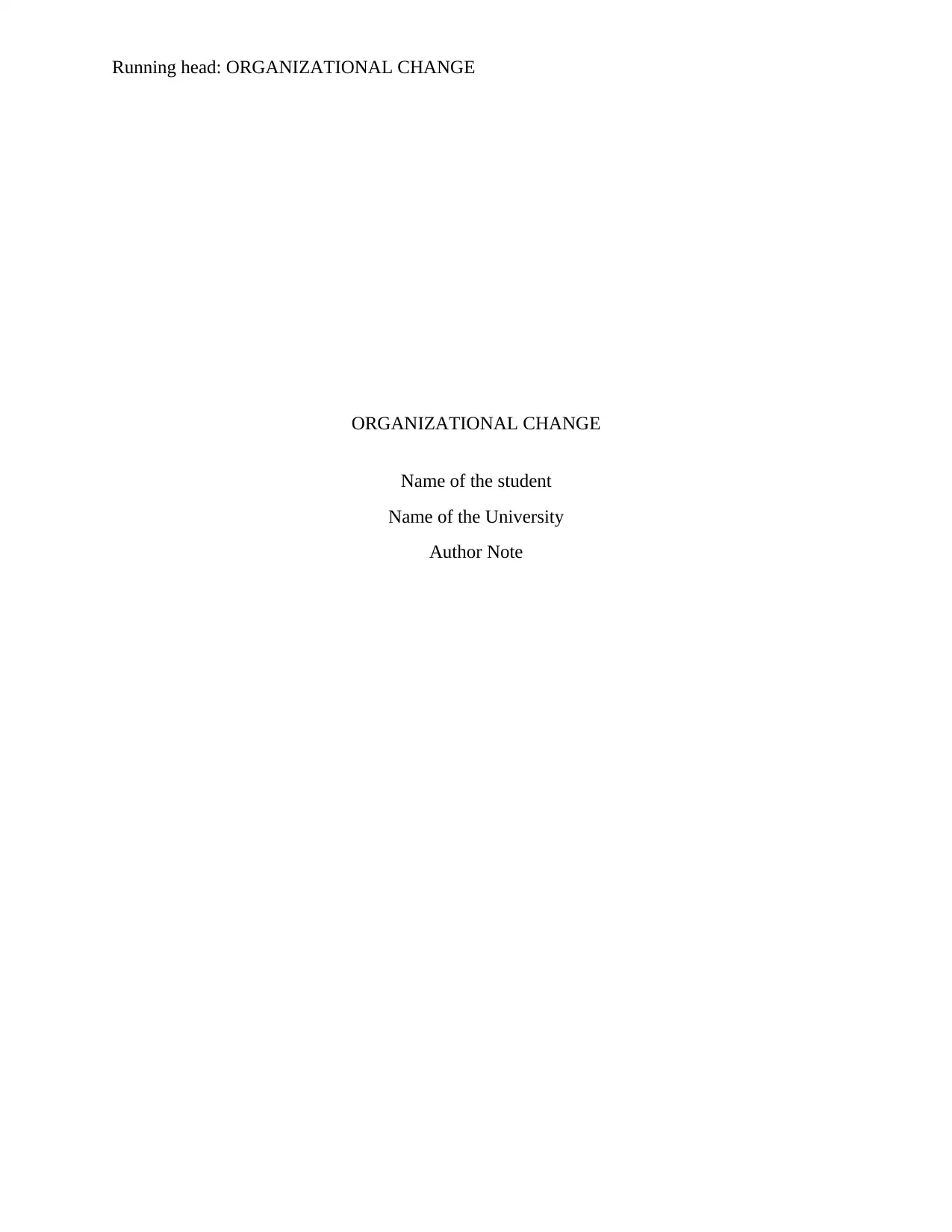
Running head: ORGANIZATIONAL CHANGE
ORGANIZATIONAL CHANGE
Name of the student
Name of the University
Author Note
ORGANIZATIONAL CHANGE
Name of the student
Name of the University
Author Note
Secure Best Marks with AI Grader
Need help grading? Try our AI Grader for instant feedback on your assignments.
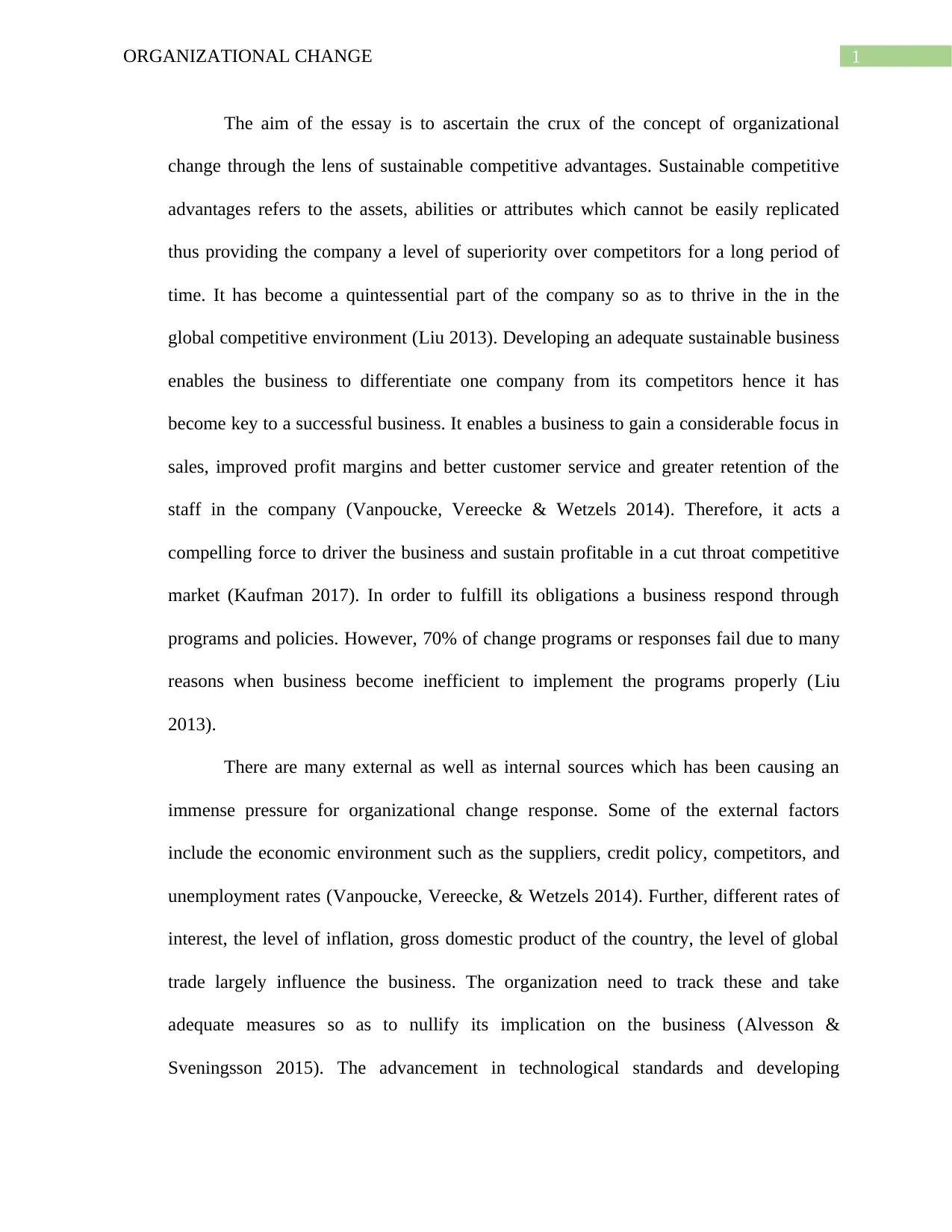
1ORGANIZATIONAL CHANGE
The aim of the essay is to ascertain the crux of the concept of organizational
change through the lens of sustainable competitive advantages. Sustainable competitive
advantages refers to the assets, abilities or attributes which cannot be easily replicated
thus providing the company a level of superiority over competitors for a long period of
time. It has become a quintessential part of the company so as to thrive in the in the
global competitive environment (Liu 2013). Developing an adequate sustainable business
enables the business to differentiate one company from its competitors hence it has
become key to a successful business. It enables a business to gain a considerable focus in
sales, improved profit margins and better customer service and greater retention of the
staff in the company (Vanpoucke, Vereecke & Wetzels 2014). Therefore, it acts a
compelling force to driver the business and sustain profitable in a cut throat competitive
market (Kaufman 2017). In order to fulfill its obligations a business respond through
programs and policies. However, 70% of change programs or responses fail due to many
reasons when business become inefficient to implement the programs properly (Liu
2013).
There are many external as well as internal sources which has been causing an
immense pressure for organizational change response. Some of the external factors
include the economic environment such as the suppliers, credit policy, competitors, and
unemployment rates (Vanpoucke, Vereecke, & Wetzels 2014). Further, different rates of
interest, the level of inflation, gross domestic product of the country, the level of global
trade largely influence the business. The organization need to track these and take
adequate measures so as to nullify its implication on the business (Alvesson &
Sveningsson 2015). The advancement in technological standards and developing
The aim of the essay is to ascertain the crux of the concept of organizational
change through the lens of sustainable competitive advantages. Sustainable competitive
advantages refers to the assets, abilities or attributes which cannot be easily replicated
thus providing the company a level of superiority over competitors for a long period of
time. It has become a quintessential part of the company so as to thrive in the in the
global competitive environment (Liu 2013). Developing an adequate sustainable business
enables the business to differentiate one company from its competitors hence it has
become key to a successful business. It enables a business to gain a considerable focus in
sales, improved profit margins and better customer service and greater retention of the
staff in the company (Vanpoucke, Vereecke & Wetzels 2014). Therefore, it acts a
compelling force to driver the business and sustain profitable in a cut throat competitive
market (Kaufman 2017). In order to fulfill its obligations a business respond through
programs and policies. However, 70% of change programs or responses fail due to many
reasons when business become inefficient to implement the programs properly (Liu
2013).
There are many external as well as internal sources which has been causing an
immense pressure for organizational change response. Some of the external factors
include the economic environment such as the suppliers, credit policy, competitors, and
unemployment rates (Vanpoucke, Vereecke, & Wetzels 2014). Further, different rates of
interest, the level of inflation, gross domestic product of the country, the level of global
trade largely influence the business. The organization need to track these and take
adequate measures so as to nullify its implication on the business (Alvesson &
Sveningsson 2015). The advancement in technological standards and developing
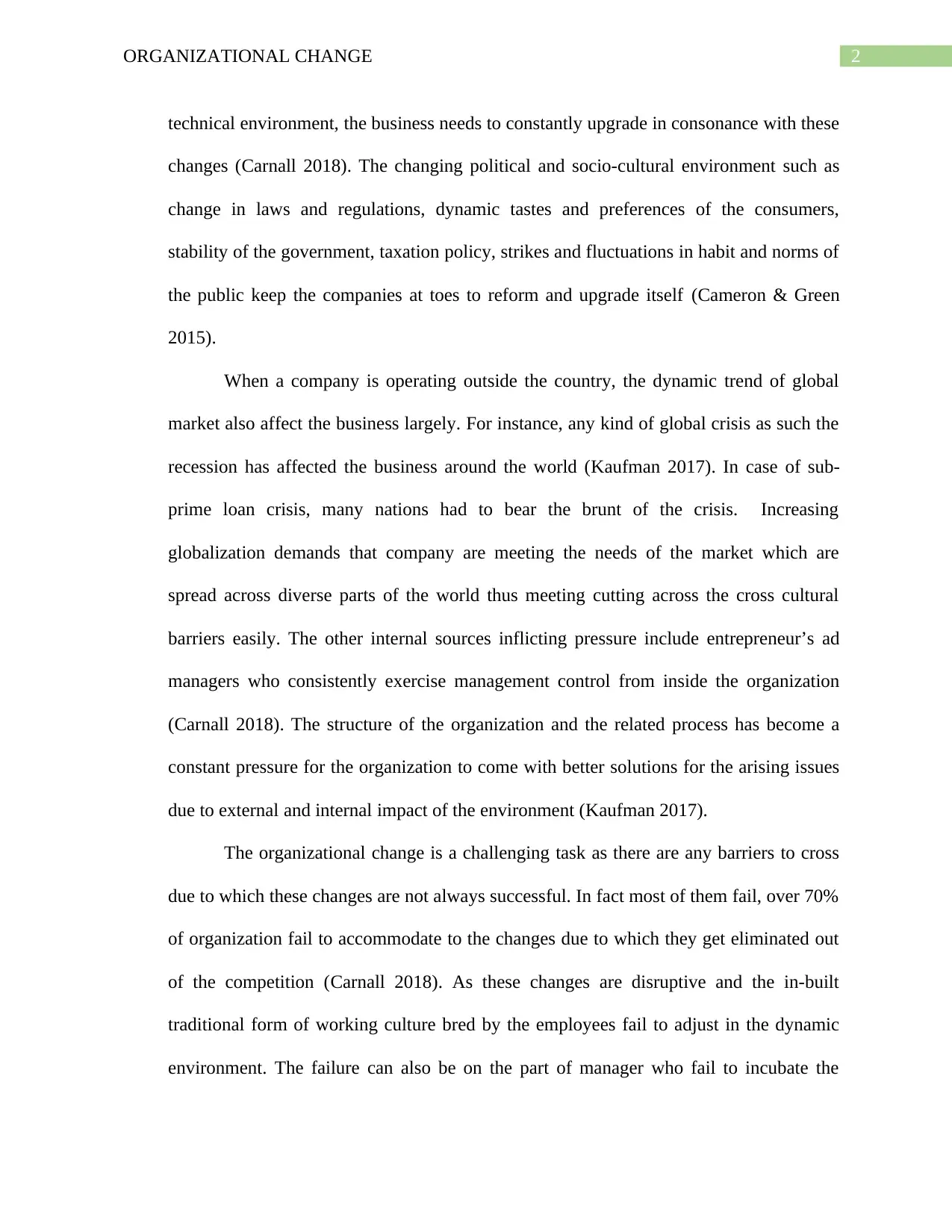
2ORGANIZATIONAL CHANGE
technical environment, the business needs to constantly upgrade in consonance with these
changes (Carnall 2018). The changing political and socio-cultural environment such as
change in laws and regulations, dynamic tastes and preferences of the consumers,
stability of the government, taxation policy, strikes and fluctuations in habit and norms of
the public keep the companies at toes to reform and upgrade itself (Cameron & Green
2015).
When a company is operating outside the country, the dynamic trend of global
market also affect the business largely. For instance, any kind of global crisis as such the
recession has affected the business around the world (Kaufman 2017). In case of sub-
prime loan crisis, many nations had to bear the brunt of the crisis. Increasing
globalization demands that company are meeting the needs of the market which are
spread across diverse parts of the world thus meeting cutting across the cross cultural
barriers easily. The other internal sources inflicting pressure include entrepreneur’s ad
managers who consistently exercise management control from inside the organization
(Carnall 2018). The structure of the organization and the related process has become a
constant pressure for the organization to come with better solutions for the arising issues
due to external and internal impact of the environment (Kaufman 2017).
The organizational change is a challenging task as there are any barriers to cross
due to which these changes are not always successful. In fact most of them fail, over 70%
of organization fail to accommodate to the changes due to which they get eliminated out
of the competition (Carnall 2018). As these changes are disruptive and the in-built
traditional form of working culture bred by the employees fail to adjust in the dynamic
environment. The failure can also be on the part of manager who fail to incubate the
technical environment, the business needs to constantly upgrade in consonance with these
changes (Carnall 2018). The changing political and socio-cultural environment such as
change in laws and regulations, dynamic tastes and preferences of the consumers,
stability of the government, taxation policy, strikes and fluctuations in habit and norms of
the public keep the companies at toes to reform and upgrade itself (Cameron & Green
2015).
When a company is operating outside the country, the dynamic trend of global
market also affect the business largely. For instance, any kind of global crisis as such the
recession has affected the business around the world (Kaufman 2017). In case of sub-
prime loan crisis, many nations had to bear the brunt of the crisis. Increasing
globalization demands that company are meeting the needs of the market which are
spread across diverse parts of the world thus meeting cutting across the cross cultural
barriers easily. The other internal sources inflicting pressure include entrepreneur’s ad
managers who consistently exercise management control from inside the organization
(Carnall 2018). The structure of the organization and the related process has become a
constant pressure for the organization to come with better solutions for the arising issues
due to external and internal impact of the environment (Kaufman 2017).
The organizational change is a challenging task as there are any barriers to cross
due to which these changes are not always successful. In fact most of them fail, over 70%
of organization fail to accommodate to the changes due to which they get eliminated out
of the competition (Carnall 2018). As these changes are disruptive and the in-built
traditional form of working culture bred by the employees fail to adjust in the dynamic
environment. The failure can also be on the part of manager who fail to incubate the
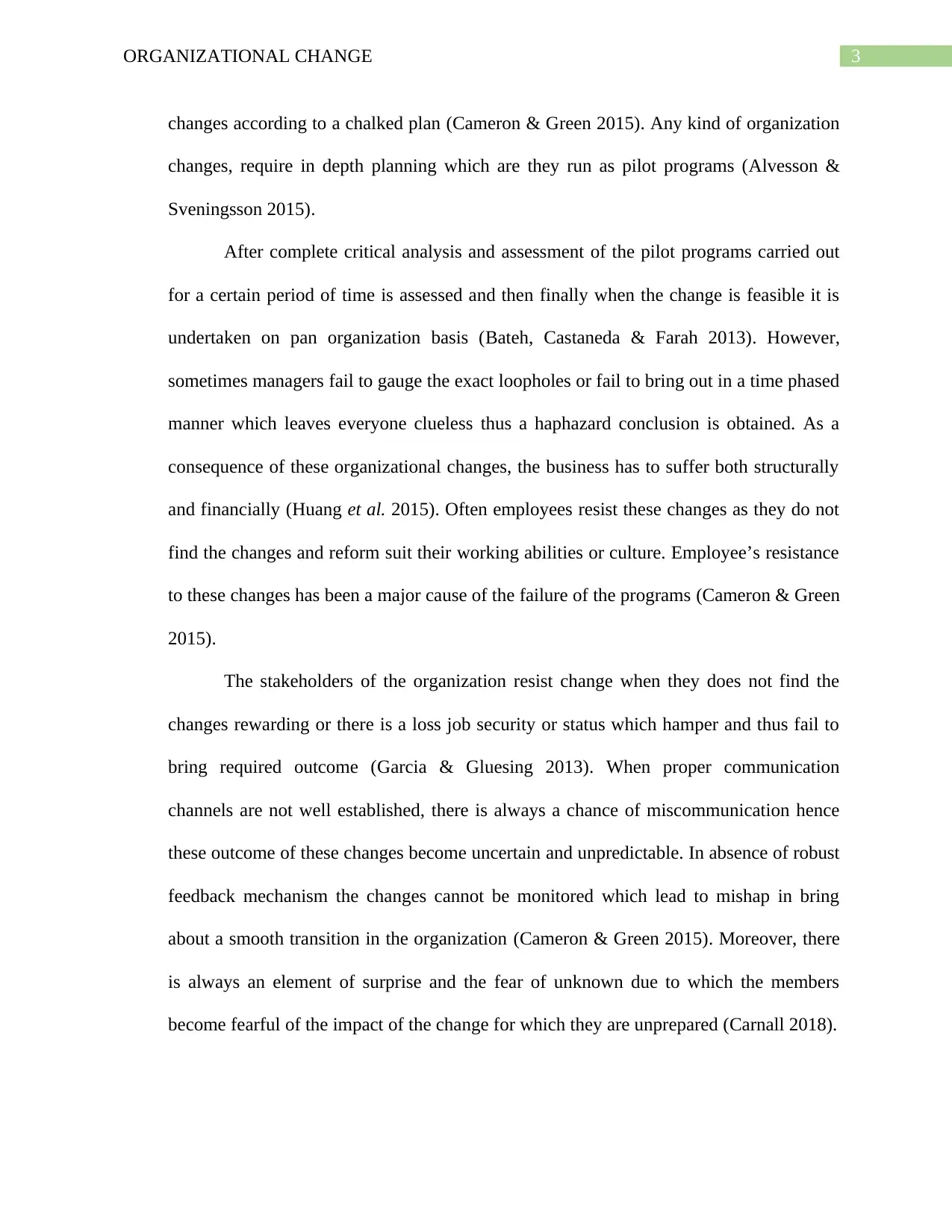
3ORGANIZATIONAL CHANGE
changes according to a chalked plan (Cameron & Green 2015). Any kind of organization
changes, require in depth planning which are they run as pilot programs (Alvesson &
Sveningsson 2015).
After complete critical analysis and assessment of the pilot programs carried out
for a certain period of time is assessed and then finally when the change is feasible it is
undertaken on pan organization basis (Bateh, Castaneda & Farah 2013). However,
sometimes managers fail to gauge the exact loopholes or fail to bring out in a time phased
manner which leaves everyone clueless thus a haphazard conclusion is obtained. As a
consequence of these organizational changes, the business has to suffer both structurally
and financially (Huang et al. 2015). Often employees resist these changes as they do not
find the changes and reform suit their working abilities or culture. Employee’s resistance
to these changes has been a major cause of the failure of the programs (Cameron & Green
2015).
The stakeholders of the organization resist change when they does not find the
changes rewarding or there is a loss job security or status which hamper and thus fail to
bring required outcome (Garcia & Gluesing 2013). When proper communication
channels are not well established, there is always a chance of miscommunication hence
these outcome of these changes become uncertain and unpredictable. In absence of robust
feedback mechanism the changes cannot be monitored which lead to mishap in bring
about a smooth transition in the organization (Cameron & Green 2015). Moreover, there
is always an element of surprise and the fear of unknown due to which the members
become fearful of the impact of the change for which they are unprepared (Carnall 2018).
changes according to a chalked plan (Cameron & Green 2015). Any kind of organization
changes, require in depth planning which are they run as pilot programs (Alvesson &
Sveningsson 2015).
After complete critical analysis and assessment of the pilot programs carried out
for a certain period of time is assessed and then finally when the change is feasible it is
undertaken on pan organization basis (Bateh, Castaneda & Farah 2013). However,
sometimes managers fail to gauge the exact loopholes or fail to bring out in a time phased
manner which leaves everyone clueless thus a haphazard conclusion is obtained. As a
consequence of these organizational changes, the business has to suffer both structurally
and financially (Huang et al. 2015). Often employees resist these changes as they do not
find the changes and reform suit their working abilities or culture. Employee’s resistance
to these changes has been a major cause of the failure of the programs (Cameron & Green
2015).
The stakeholders of the organization resist change when they does not find the
changes rewarding or there is a loss job security or status which hamper and thus fail to
bring required outcome (Garcia & Gluesing 2013). When proper communication
channels are not well established, there is always a chance of miscommunication hence
these outcome of these changes become uncertain and unpredictable. In absence of robust
feedback mechanism the changes cannot be monitored which lead to mishap in bring
about a smooth transition in the organization (Cameron & Green 2015). Moreover, there
is always an element of surprise and the fear of unknown due to which the members
become fearful of the impact of the change for which they are unprepared (Carnall 2018).
Secure Best Marks with AI Grader
Need help grading? Try our AI Grader for instant feedback on your assignments.
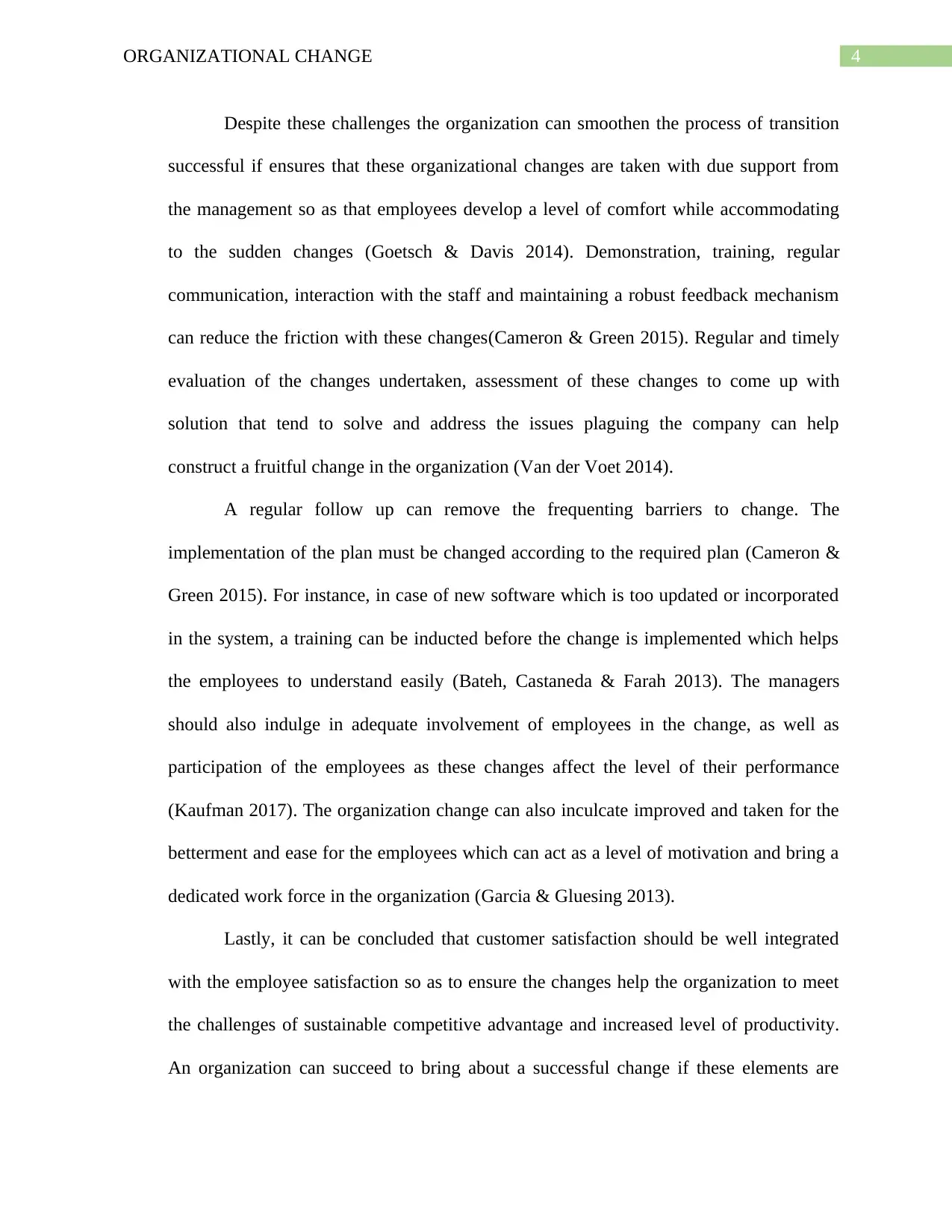
4ORGANIZATIONAL CHANGE
Despite these challenges the organization can smoothen the process of transition
successful if ensures that these organizational changes are taken with due support from
the management so as that employees develop a level of comfort while accommodating
to the sudden changes (Goetsch & Davis 2014). Demonstration, training, regular
communication, interaction with the staff and maintaining a robust feedback mechanism
can reduce the friction with these changes(Cameron & Green 2015). Regular and timely
evaluation of the changes undertaken, assessment of these changes to come up with
solution that tend to solve and address the issues plaguing the company can help
construct a fruitful change in the organization (Van der Voet 2014).
A regular follow up can remove the frequenting barriers to change. The
implementation of the plan must be changed according to the required plan (Cameron &
Green 2015). For instance, in case of new software which is too updated or incorporated
in the system, a training can be inducted before the change is implemented which helps
the employees to understand easily (Bateh, Castaneda & Farah 2013). The managers
should also indulge in adequate involvement of employees in the change, as well as
participation of the employees as these changes affect the level of their performance
(Kaufman 2017). The organization change can also inculcate improved and taken for the
betterment and ease for the employees which can act as a level of motivation and bring a
dedicated work force in the organization (Garcia & Gluesing 2013).
Lastly, it can be concluded that customer satisfaction should be well integrated
with the employee satisfaction so as to ensure the changes help the organization to meet
the challenges of sustainable competitive advantage and increased level of productivity.
An organization can succeed to bring about a successful change if these elements are
Despite these challenges the organization can smoothen the process of transition
successful if ensures that these organizational changes are taken with due support from
the management so as that employees develop a level of comfort while accommodating
to the sudden changes (Goetsch & Davis 2014). Demonstration, training, regular
communication, interaction with the staff and maintaining a robust feedback mechanism
can reduce the friction with these changes(Cameron & Green 2015). Regular and timely
evaluation of the changes undertaken, assessment of these changes to come up with
solution that tend to solve and address the issues plaguing the company can help
construct a fruitful change in the organization (Van der Voet 2014).
A regular follow up can remove the frequenting barriers to change. The
implementation of the plan must be changed according to the required plan (Cameron &
Green 2015). For instance, in case of new software which is too updated or incorporated
in the system, a training can be inducted before the change is implemented which helps
the employees to understand easily (Bateh, Castaneda & Farah 2013). The managers
should also indulge in adequate involvement of employees in the change, as well as
participation of the employees as these changes affect the level of their performance
(Kaufman 2017). The organization change can also inculcate improved and taken for the
betterment and ease for the employees which can act as a level of motivation and bring a
dedicated work force in the organization (Garcia & Gluesing 2013).
Lastly, it can be concluded that customer satisfaction should be well integrated
with the employee satisfaction so as to ensure the changes help the organization to meet
the challenges of sustainable competitive advantage and increased level of productivity.
An organization can succeed to bring about a successful change if these elements are
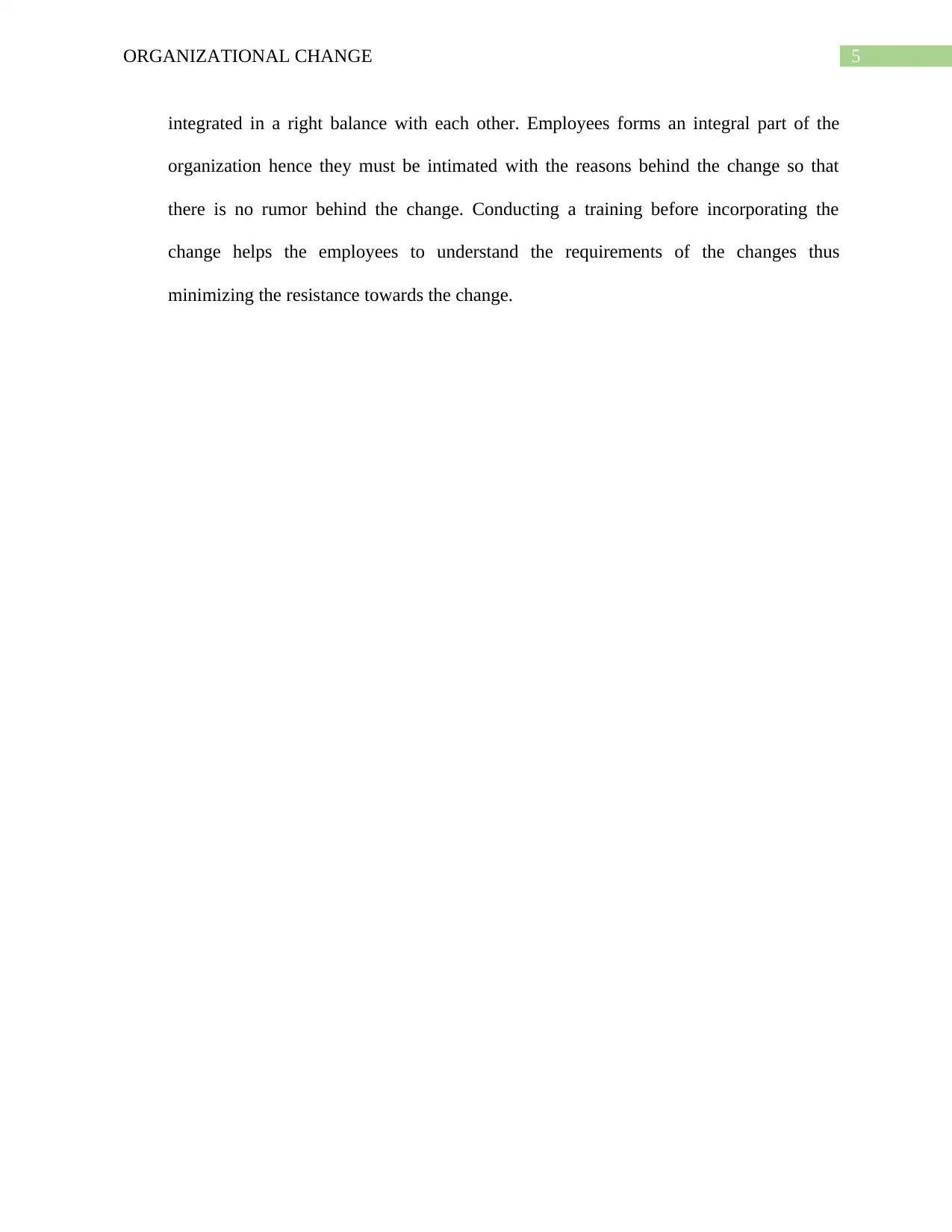
5ORGANIZATIONAL CHANGE
integrated in a right balance with each other. Employees forms an integral part of the
organization hence they must be intimated with the reasons behind the change so that
there is no rumor behind the change. Conducting a training before incorporating the
change helps the employees to understand the requirements of the changes thus
minimizing the resistance towards the change.
integrated in a right balance with each other. Employees forms an integral part of the
organization hence they must be intimated with the reasons behind the change so that
there is no rumor behind the change. Conducting a training before incorporating the
change helps the employees to understand the requirements of the changes thus
minimizing the resistance towards the change.
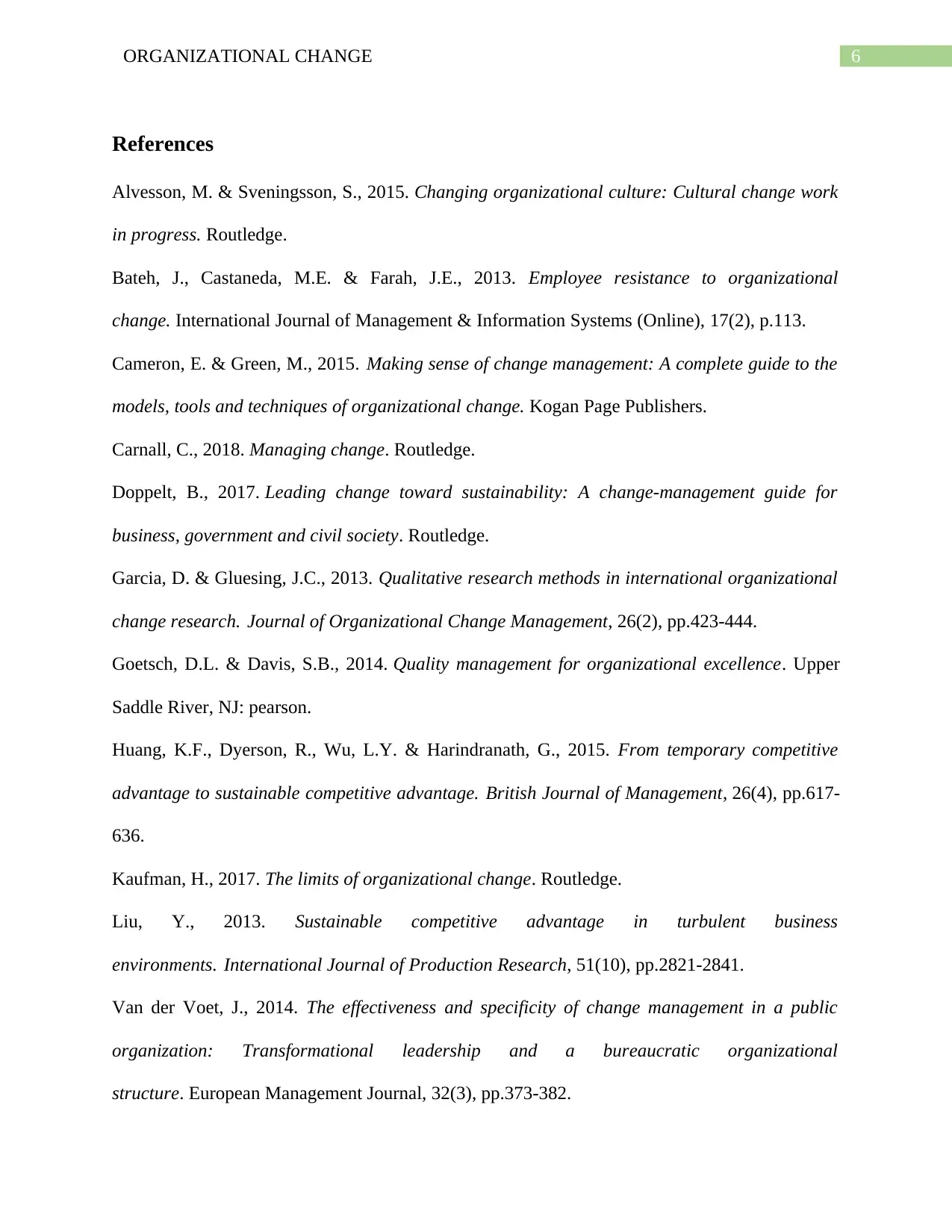
6ORGANIZATIONAL CHANGE
References
Alvesson, M. & Sveningsson, S., 2015. Changing organizational culture: Cultural change work
in progress. Routledge.
Bateh, J., Castaneda, M.E. & Farah, J.E., 2013. Employee resistance to organizational
change. International Journal of Management & Information Systems (Online), 17(2), p.113.
Cameron, E. & Green, M., 2015. Making sense of change management: A complete guide to the
models, tools and techniques of organizational change. Kogan Page Publishers.
Carnall, C., 2018. Managing change. Routledge.
Doppelt, B., 2017. Leading change toward sustainability: A change-management guide for
business, government and civil society. Routledge.
Garcia, D. & Gluesing, J.C., 2013. Qualitative research methods in international organizational
change research. Journal of Organizational Change Management, 26(2), pp.423-444.
Goetsch, D.L. & Davis, S.B., 2014. Quality management for organizational excellence. Upper
Saddle River, NJ: pearson.
Huang, K.F., Dyerson, R., Wu, L.Y. & Harindranath, G., 2015. From temporary competitive
advantage to sustainable competitive advantage. British Journal of Management, 26(4), pp.617-
636.
Kaufman, H., 2017. The limits of organizational change. Routledge.
Liu, Y., 2013. Sustainable competitive advantage in turbulent business
environments. International Journal of Production Research, 51(10), pp.2821-2841.
Van der Voet, J., 2014. The effectiveness and specificity of change management in a public
organization: Transformational leadership and a bureaucratic organizational
structure. European Management Journal, 32(3), pp.373-382.
References
Alvesson, M. & Sveningsson, S., 2015. Changing organizational culture: Cultural change work
in progress. Routledge.
Bateh, J., Castaneda, M.E. & Farah, J.E., 2013. Employee resistance to organizational
change. International Journal of Management & Information Systems (Online), 17(2), p.113.
Cameron, E. & Green, M., 2015. Making sense of change management: A complete guide to the
models, tools and techniques of organizational change. Kogan Page Publishers.
Carnall, C., 2018. Managing change. Routledge.
Doppelt, B., 2017. Leading change toward sustainability: A change-management guide for
business, government and civil society. Routledge.
Garcia, D. & Gluesing, J.C., 2013. Qualitative research methods in international organizational
change research. Journal of Organizational Change Management, 26(2), pp.423-444.
Goetsch, D.L. & Davis, S.B., 2014. Quality management for organizational excellence. Upper
Saddle River, NJ: pearson.
Huang, K.F., Dyerson, R., Wu, L.Y. & Harindranath, G., 2015. From temporary competitive
advantage to sustainable competitive advantage. British Journal of Management, 26(4), pp.617-
636.
Kaufman, H., 2017. The limits of organizational change. Routledge.
Liu, Y., 2013. Sustainable competitive advantage in turbulent business
environments. International Journal of Production Research, 51(10), pp.2821-2841.
Van der Voet, J., 2014. The effectiveness and specificity of change management in a public
organization: Transformational leadership and a bureaucratic organizational
structure. European Management Journal, 32(3), pp.373-382.
Paraphrase This Document
Need a fresh take? Get an instant paraphrase of this document with our AI Paraphraser
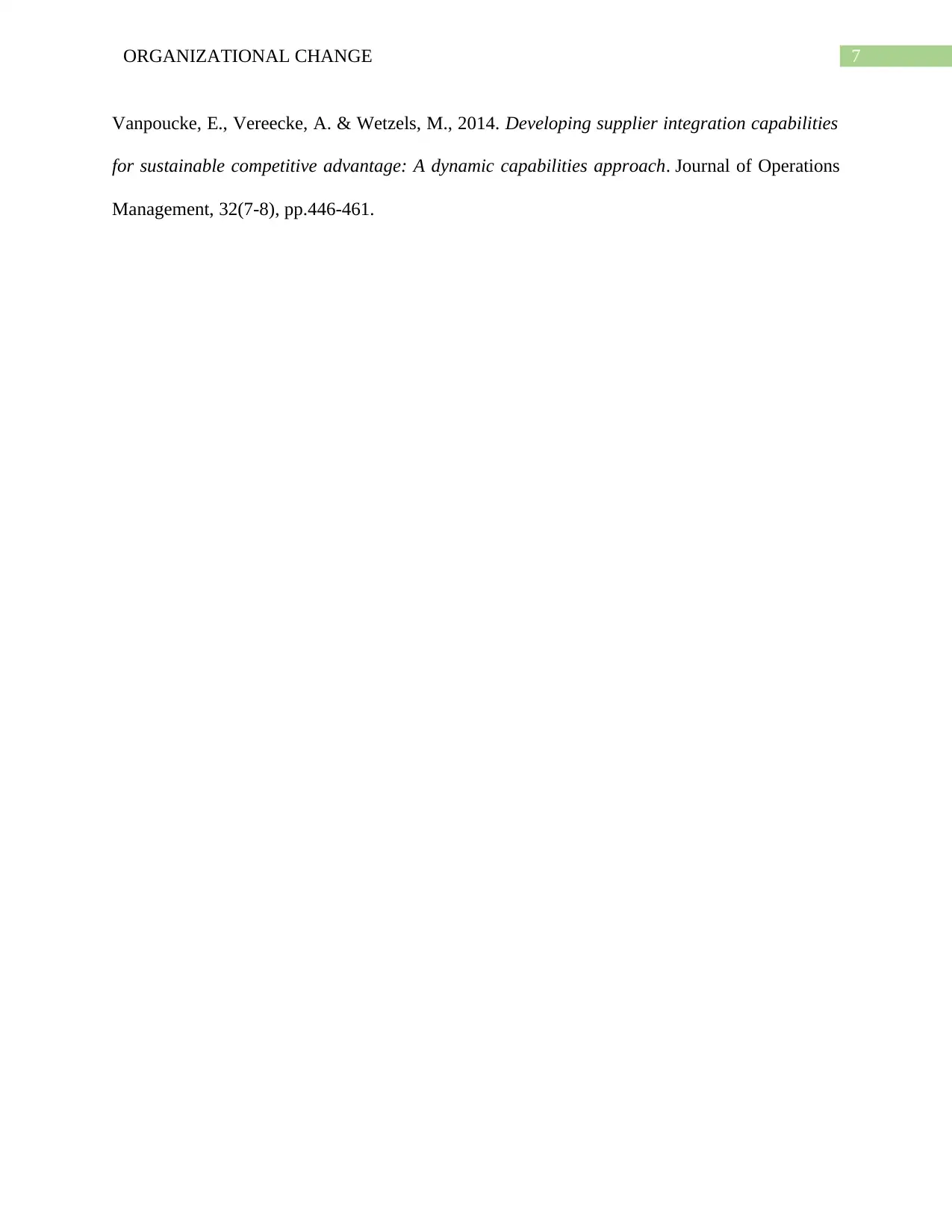
7ORGANIZATIONAL CHANGE
Vanpoucke, E., Vereecke, A. & Wetzels, M., 2014. Developing supplier integration capabilities
for sustainable competitive advantage: A dynamic capabilities approach. Journal of Operations
Management, 32(7-8), pp.446-461.
Vanpoucke, E., Vereecke, A. & Wetzels, M., 2014. Developing supplier integration capabilities
for sustainable competitive advantage: A dynamic capabilities approach. Journal of Operations
Management, 32(7-8), pp.446-461.
1 out of 8
Related Documents
Your All-in-One AI-Powered Toolkit for Academic Success.
+13062052269
info@desklib.com
Available 24*7 on WhatsApp / Email
![[object Object]](/_next/static/media/star-bottom.7253800d.svg)
Unlock your academic potential
© 2024 | Zucol Services PVT LTD | All rights reserved.




